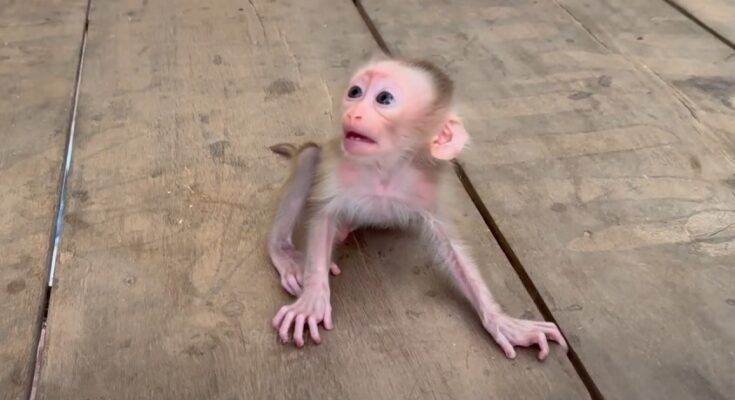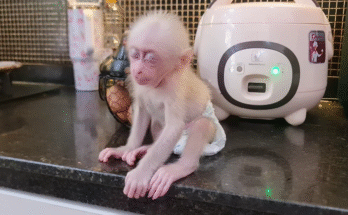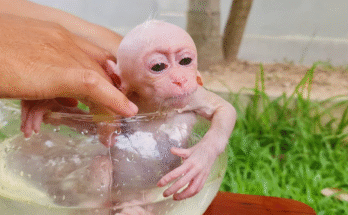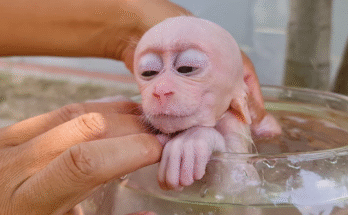A newborn monkey’s journey begins with tiny, unsteady steps, guided by the soothing sounds of its mother. At first, it clings tightly, relying on her warmth and heartbeat for comfort. As days pass, soft coos and gentle encouragement urge the baby to attempt its first movements. Every wobbly step is a milestone, with the rustling leaves and distant calls of the troop shaping its world. The rhythmic pitter-patter of tiny feet marks progress, building strength and confidence. Step by step, the newborn monkey learns to navigate its surroundings, a testament to resilience and the beauty of nature’s rhythm.
Newborn monkeys enter the world fragile and completely dependent on their mothers. Walking is not an immediate ability but a gradual process influenced by their instincts, environment, and social interactions. The sounds around them—soft vocalizations, rustling leaves, and distant troop calls—play a vital role in their development. This article explores five key aspects of how newborn monkeys learn to walk, step by step, guided by the rhythms of nature.
1. The First Steps: From Clinging to Crawling
At birth, a newborn monkey lacks the strength to walk independently. Instead, it clings tightly to its mother’s fur, feeling comforted by her heartbeat and warmth. In the first few days, the baby begins experimenting with small movements, attempting to shift its position while still holding on. Soft cooing sounds from the mother encourage the baby to stay close, while her movements provide a natural rhythm, teaching the infant how to balance and adjust. This stage is crucial for muscle development, laying the foundation for future mobility.
2. Recognizing Sounds and Environmental Cues
As the baby monkey grows, it becomes more aware of the sounds surrounding it. The gentle rustling of leaves, the distant calls of its troop, and its mother’s reassuring vocalizations help shape its sense of space and direction. These sounds act as an auditory guide, signaling when to move, pause, or seek safety. By listening and responding to these cues, the newborn learns to associate movement with security, gradually building the confidence to step away from its mother for short moments.
3. Strengthening Muscles: Small Steps with Big Progress
By the second or third week, the baby monkey begins testing its strength by attempting short, shaky steps while still supported by its mother. The soft padding of the forest floor absorbs its tiny missteps, allowing it to explore safely. At this stage, it starts using its hands and feet more effectively, gripping tree roots or nearby objects for balance. The rhythmic sounds of footsteps from other monkeys in the troop further encourage movement, signaling that walking is a natural and essential part of survival.
4. Learning Through Play and Interaction
Playtime is a crucial element in the development of walking skills. As the baby monkey interacts with siblings and other young members of the troop, it mimics their movements, learning through observation and practice. Small jumps, playful chases, and gentle tumbles refine coordination. The sounds of laughter-like vocalizations from other juveniles act as encouragement, reinforcing positive movement. With each playful step, the baby gains more confidence, transitioning from hesitant movements to purposeful strides.
5. Achieving Independence: Walking with Confidence
By the end of the first month, the baby monkey can take independent steps, though it still remains close to its mother. The once-fragile newborn now moves more steadily, using the sounds of nature—chirping birds, rustling leaves, and the rhythmic footsteps of the troop—as a guide. This stage marks a significant milestone in its journey toward independence. While it may still stumble occasionally, the baby monkey’s ability to walk confidently signals a new chapter in its development, preparing it for the challenges and adventures ahead.
Conclusion
The process of learning to walk is a remarkable journey for a newborn monkey. Step by step, guided by sounds and instincts, it transforms from a fragile newborn into a curious, active member of its troop. The role of maternal care, environmental cues, and playful interactions all contribute to this gradual but essential development. Each step is a testament to resilience, adaptation, and the beauty of life in the wild.
Pulling at Heartstrings: A Newborn Monkey’s Struggle
In the heart of the jungle, a fragile newborn monkey fights for survival. Born into challenging conditions, its tiny cries echo through the trees, pulling at the heartstrings of those who witness its struggle. With its delicate frame and helpless gaze, the baby monkey depends entirely on the compassion and care of its family to endure the harsh environment. This touching story is a powerful reminder of the resilience of life and the importance of empathy. Viewers are left captivated by the raw emotions of the little fighter’s journey, making this tale an unforgettable glimpse into the beauty and fragility of nature.
Caring for a newborn monkey at home is both a rewarding and challenging responsibility. These delicate creatures require specialized care to ensure their healthy growth and development. This guide will cover essential aspects of providing proper care for a newborn monkey, helping you create an environment where they can thrive.
1. Create a Safe and Comfortable Environment
Newborn monkeys are highly vulnerable to environmental changes. Start by setting up a warm, secure, and clean space for them. Use a soft blanket-lined incubator or a small enclosure that maintains a stable temperature between 85–90°F. Ensure the space is free from sharp objects and potential hazards.
To mimic their natural environment, provide a small stuffed toy or cloth to offer comfort and simulate their mother’s presence. Regularly clean the enclosure to avoid infections.
2. Provide Proper Nutrition
Feeding is crucial for the growth of a newborn monkey. Purchase a high-quality primate milk formula, as cow’s milk can cause digestive issues. Use a sterilized baby bottle or syringe to feed them every 2–3 hours, including during the night. Always warm the milk to body temperature before feeding and hold the monkey securely to ensure they feel safe.
Gradually adjust feeding intervals and introduce solid foods like mashed fruits or vegetables as they grow older. Consult with a veterinarian to determine the right feeding schedule and dietary supplements.
3. Maintain Hygiene
Hygiene is essential to prevent infections. Sterilize feeding equipment after each use and clean their enclosure daily. Use baby wipes or a damp, soft cloth to clean their skin if they become dirty, and ensure they are thoroughly dried afterward.
Newborn monkeys often require assistance with urination and defecation. Gently rub their abdomen and genital area with a damp cotton ball to stimulate these processes, mimicking their mother’s care.
4. Monitor Health and Growth
Newborn monkeys are prone to illnesses, so regular health monitoring is vital. Observe their behavior, weight gain, and energy levels closely. Signs of dehydration, lethargy, or poor appetite require immediate veterinary attention.
Schedule regular check-ups with an exotic animal veterinarian experienced in primates. Keep up-to-date with necessary vaccinations and discuss any health concerns promptly.
5. Provide Social Interaction
Monkeys are highly social animals and thrive on interaction. Spend quality time with your monkey to build trust and emotional security. Gently hold and talk to them, mimicking the comfort they would receive from their mother.
If possible, introduce them to other monkeys or suitable playmates as they grow older to encourage natural social behaviors. Always supervise interactions to ensure safety.
6. Understand Legal and Ethical Responsibilities
Before bringing a newborn monkey home, ensure compliance with local laws and regulations regarding primate ownership. Monkeys are exotic animals, and owning one comes with significant ethical responsibilities. Consider their long-term needs and whether you can provide lifelong care.
7. Prepare for Long-Term Commitment
Newborn monkeys grow quickly and develop complex needs. They require mental stimulation, a balanced diet, and consistent care throughout their lives. Invest in toys, climbing structures, and other enrichment tools to keep them engaged and healthy.
Additionally, educate yourself continuously about monkey care through books, online resources, and consultations with experts.
Conclusion
Caring for a newborn monkey at home is a lifelong commitment that demands time, effort, and resources. By providing a safe environment, proper nutrition, social interaction, and regular medical care, you can ensure the well-being of your little companion. Always prioritize their health and happiness, and remember that responsible ownership is key to a fulfilling relationship with your monkey.



